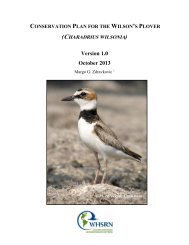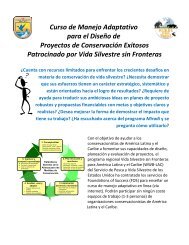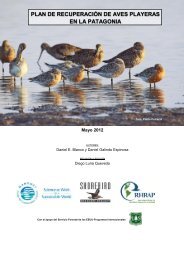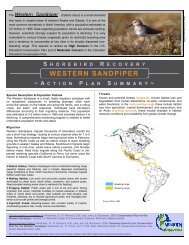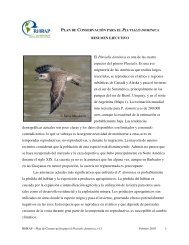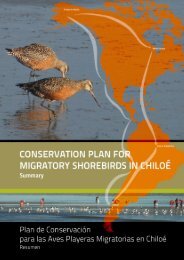Sanderling Plan - Western Hemisphere Shorebird Reserve Network
Sanderling Plan - Western Hemisphere Shorebird Reserve Network
Sanderling Plan - Western Hemisphere Shorebird Reserve Network
Create successful ePaper yourself
Turn your PDF publications into a flip-book with our unique Google optimized e-Paper software.
However, the use of energetics in shorebird conservation planning carries a word of<br />
caution. Because conservation takes place within a limited framework (limited funds, time, and<br />
effort), conservationists are often asked to define a certain minimal goal, such as to identify the<br />
minimum number of important sites needed to meet an objective (i.e., that a species of interest<br />
may complete its migration). Although this approach has conceptual appeal for its simplicity, it<br />
is an inappropriate guiding framework for <strong>Sanderling</strong> (or shorebird) conservation for several<br />
important reasons: 1) stopover sites host a mix of individuals that originate from different<br />
locations and that are headed to different destinations (and therefore, only the furthest potential<br />
destination should be considered the ‘minimum’ distance); 2) many <strong>Sanderling</strong> habitats are<br />
experiencing increased levels of disturbance or dangers, and hence <strong>Sanderling</strong> will likely expend<br />
additional effort and energy in order to build up fat reserves (even if an ‘adequate’ food supply is<br />
present); and 3) any biggest-bang-for-the-buck approach invariably selects sites that host large<br />
numbers of birds; while this appears most efficient from a conservationist’s standpoint, it does<br />
not take into consideration the potential importance of maintaining ‘smaller’ sites (to enable<br />
spatial segregation among and within species), given that some species (e.g., aggregated) may<br />
fare better than others (e.g., dispersed) if crowded into a small set of sites. Finally, despite<br />
uncertainties as to effects on specific locations, in the age of climate change we may no longer<br />
have much room for error. We may find ourselves in the coming decades engaging in some<br />
serious hands-on actions to save this and other species. Hence, it is prudent to target a<br />
conservation approach that, while ambitious, is most likely to support their ecology and spread<br />
out the risk due to stochastic events.<br />
MONITORING<br />
In North America, <strong>Sanderling</strong> (along with other shorebird species) populations have been<br />
monitored by the International <strong>Shorebird</strong> Survey since the mid 1970s. Regional monitoring<br />
efforts that record <strong>Sanderling</strong>s also include the Canadian Maritime <strong>Shorebird</strong> Survey, the Pacific<br />
Flyways Project (active during the 1980s along the Pacific U.S. Coast), the <strong>Western</strong> <strong>Shorebird</strong><br />
Survey (initiated in 2000), the <strong>Western</strong> Atlantic <strong>Shorebird</strong> Association (currently active along<br />
the U.S. Atlantic), and the South Atlantic Migratory Bird Initiative (SAMBI), among others. In<br />
addition, individual researchers have gathered multiple years of data on the <strong>Sanderling</strong> in<br />
specific parts of its range, for example in Arcata and Bodega Bay, California; Delaware Bay,<br />
WHSRN – <strong>Sanderling</strong> Conservation <strong>Plan</strong>, February 2010, v1.1 65





